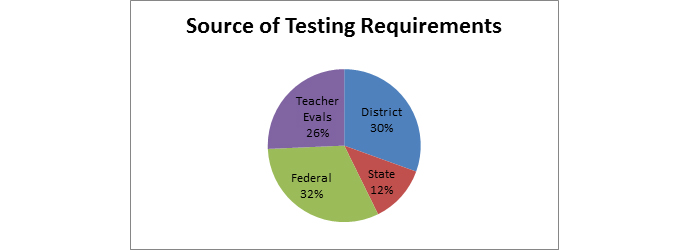Though hardly the only issue to be debated during the reauthorization of the Elementary and Secondary Education act, annual testing has taken center stage in discussions so far. Lamar Alexander, chairman of the Senate HELP committee, put forth a bill that leaves open the possibility of removing the federal requirement that states test students annually in reading and math from grades three through eight—a possibility that has thoroughly freaked out much of the education-reform community.
But as Alexander has explained, he is merely trying to respond to what he and every other member of Congress are hearing from their constituents: There’s too much damn testing in the schools.
But is that true? And if so, is it because of the federal requirements?
A new report from the Ohio Department of Education provides some timely answers, at least for one state. (A bellwether state, mind you.) State Superintendent Dick Ross charged his department with collecting information about the number of hours Buckeye State students spend preparing for and taking tests (not including tests developed by their own teachers). The findings are illuminating (most of this language is verbatim):
• The average student spends approximately 19.8 hours taking tests each year. This is only 1-3 percent of the school year, depending on grade level. Kindergarten students spend the least amount of time on testing (11.3 hours on average), while grade-10 students spend the most (28.4 hours on average).
• Students spend approximately 15 additional hours practicing for tests each year.
• Tests used to feed teacher evaluations are one of the largest drivers of testing time of all tests. Approximately 26 percent of total student test-taking time is spent taking “student learning objective” tests.
That last point may be the most important one. As I’ve argued before, the federal requirement that is driving the over-testing concern isn’t the mandate that states test students annually in grades 3–8; it’s the mandate (dreamed up by Arne Duncan as a condition of ESEA waivers) that states develop teacher-evaluation systems that include student achievement as a significant factor.
The problem is that most teachers—two-thirds in Ohio’s case—don’t have “value added” data because they don’t teach subjects and/or grades with valid state assessments. So rather than just use other measures to evaluate those teachers—like observations—states encouraged the creation of “student learning objectives” to fill the gap. In the Ohio report’s words:
Student learning objectives are measurable, long-term academic growth targets that a teacher sets at the beginning of the year for all students. The teacher or school creates and administers student learning objective tests to measure each student’s progress on each growth target. Generally, these tests are given twice a year; once at the beginning of the year and again at the end of the year.
It’s not hard to understand, then, how this recent development has increased the testing burden dramatically.
To his credit, State Superintendent Ross recommends killing off these student learning objectives in Ohio for pre-k–3 classes, as well as non-core subject areas in grades 4–12. He also wants to limit testing time to 2 percent of instructional hours and test prep to 1 percent. This all makes a ton of sense to me.
But back to ESEA. How should members of Congress address the over-testing concern? They might start by studying this chart (I pulled the data from Appendix 2 of the Ohio report):
What might they conclude?
1. It’s absolutely true that federal requirements are driving much of the testing burden—both the accountability tests (represented by the green slice of the pie) and the “student learning objectives” for teacher evaluation purposes (the purple).
2. One way to reduce the testing burden is to move to grade-span testing, thus shrinking the “green” slice significantly. But they can make an even bigger dent by eliminating the federal teacher-evaluation mandate—which is precisely what Lamar Alexander’s bill does.
Finally, they might conclude that Dick Ross would make an excellent witness at this week’s Senate HELP committee hearing on testing!
—Michael J. Petrilli
This first appeared on Flypaper.



